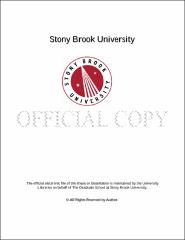| dc.identifier.uri | http://hdl.handle.net/11401/76849 | |
| dc.description.sponsorship | This work is sponsored by the Stony Brook University Graduate School in compliance with the requirements for completion of degree. | en_US |
| dc.format | Monograph | |
| dc.format.medium | Electronic Resource | en_US |
| dc.language.iso | en_US | |
| dc.publisher | The Graduate School, Stony Brook University: Stony Brook, NY. | |
| dc.type | Dissertation | |
| dcterms.abstract | How do contemporary artworks address and give visibility to the wounded body without reinvigorating trauma, without repeating the spectacular and homogenizing strategies used by the media? How do artworks move beyond denunciation to aesthetically and historically name and rearticulate bodily violence? And fundamentally, how do artworks offer an historical understanding of the political historicity of contemporary violence without uncritically resorting to myth and structural trauma? We intend to answer these questions within the context of art and violence in Colombia in 1990s. In this direction, we examine four artworks produced between 1993 and 1998, by artists Alberto Baraya, Clemencia Echeverri, José Alejandro Restrepo, and Juan Manuel EchavarrÃa; artworks that deal with the challenge of thematizing trauma and memory of violence in conditions of coloniality, particularly in relation to spectacular and terrifying mutilations produced during the period. These artworks have been traditionally regarded in terms of a registration or denunciation of violence and (neo)colonialism, or else in terms of registration of collective trauma. In this study, however, we show that these works also problematize themselves with regards to such acts of registration and denunciation [in order to] critically address cultural mechanisms of memory. More precisely, we argue that these artworks inaugurate an effort of offering decolonial redistributions of the sensible that reveal, interrupt, and rearticulate ways in which historical trauma and loss have been problematically assumed, by Colombian society at large and artworks in particular, in terms of myth, absence, and transhistorical structural trauma. We finally analyze these group of artworks as a constellation (i.e., bringing them together without reducing one to the other or to a general idea), and build from them a map that help us to conceptualize how they mobilize techniques of parody and subversion in order to deal with trauma and loss. This map may serve, in the future, for further studies of artworks produced during the period and later. In this study we have interpreted and appropriated Dominick LaCapra’s analysis of absence, loss and trauma, Jacques Rancière’s notion of redistribution of the sensible, and Santiago Castro-Gómez’s and Ramón Grosfoguel’s decolonial proposal. | |
| dcterms.abstract | How do contemporary artworks address and give visibility to the wounded body without reinvigorating trauma, without repeating the spectacular and homogenizing strategies used by the media? How do artworks move beyond denunciation to aesthetically and historically name and rearticulate bodily violence? And fundamentally, how do artworks offer an historical understanding of the political historicity of contemporary violence without uncritically resorting to myth and structural trauma? We intend to answer these questions within the context of art and violence in Colombia in 1990s. In this direction, we examine four artworks produced between 1993 and 1998, by artists Alberto Baraya, Clemencia Echeverri, José Alejandro Restrepo, and Juan Manuel Echavarría; artworks that deal with the challenge of thematizing trauma and memory of violence in conditions of coloniality, particularly in relation to spectacular and terrifying mutilations produced during the period. These artworks have been traditionally regarded in terms of a registration or denunciation of violence and (neo)colonialism, or else in terms of registration of collective trauma. In this study, however, we show that these works also problematize themselves with regards to such acts of registration and denunciation [in order to] critically address cultural mechanisms of memory. More precisely, we argue that these artworks inaugurate an effort of offering decolonial redistributions of the sensible that reveal, interrupt, and rearticulate ways in which historical trauma and loss have been problematically assumed, by Colombian society at large and artworks in particular, in terms of myth, absence, and transhistorical structural trauma. We finally analyze these group of artworks as a constellation (i.e., bringing them together without reducing one to the other or to a general idea), and build from them a map that help us to conceptualize how they mobilize techniques of parody and subversion in order to deal with trauma and loss. This map may serve, in the future, for further studies of artworks produced during the period and later. In this study we have interpreted and appropriated Dominick LaCapra’s analysis of absence, loss and trauma, Jacques Rancière’s notion of redistribution of the sensible, and Santiago Castro-Gómez’s and Ramón Grosfoguel’s decolonial proposal. | |
| dcterms.available | 2017-09-20T16:51:19Z | |
| dcterms.contributor | Uroskie, Andrew | en_US |
| dcterms.contributor | Lutterbie, John | en_US |
| dcterms.contributor | O'Byrne, Anne. | en_US |
| dcterms.contributor | Frank, Barbara | en_US |
| dcterms.creator | GUERRERO HERNANDEZ, JUAN CARLOS | |
| dcterms.dateAccepted | 2017-09-20T16:51:19Z | |
| dcterms.dateSubmitted | 2017-09-20T16:51:19Z | |
| dcterms.description | Department of Art History and Criticism. | en_US |
| dcterms.extent | 279 pg. | en_US |
| dcterms.format | Monograph | |
| dcterms.format | Application/PDF | en_US |
| dcterms.identifier | http://hdl.handle.net/11401/76849 | |
| dcterms.issued | 2015-12-01 | |
| dcterms.language | en_US | |
| dcterms.provenance | Made available in DSpace on 2017-09-20T16:51:19Z (GMT). No. of bitstreams: 1
GUERREROHERNANDEZ_grad.sunysb_0771E_12688.pdf: 5527970 bytes, checksum: c914e561a0dfbc9e2070d4fc4582b665 (MD5)
Previous issue date: 1 | en |
| dcterms.publisher | The Graduate School, Stony Brook University: Stony Brook, NY. | |
| dcterms.subject | Photography, Trauma, Video, Violence | |
| dcterms.subject | Art history | |
| dcterms.title | Mutilated bodies and memories of violence: Displacements and contestations of representations of violence, in contemporary video art and photography in Colombia, 1993-1998. | |
| dcterms.type | Dissertation | |

